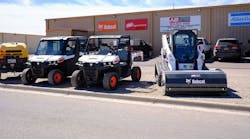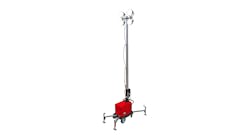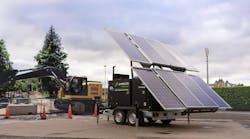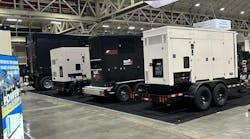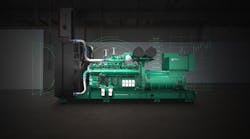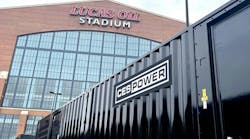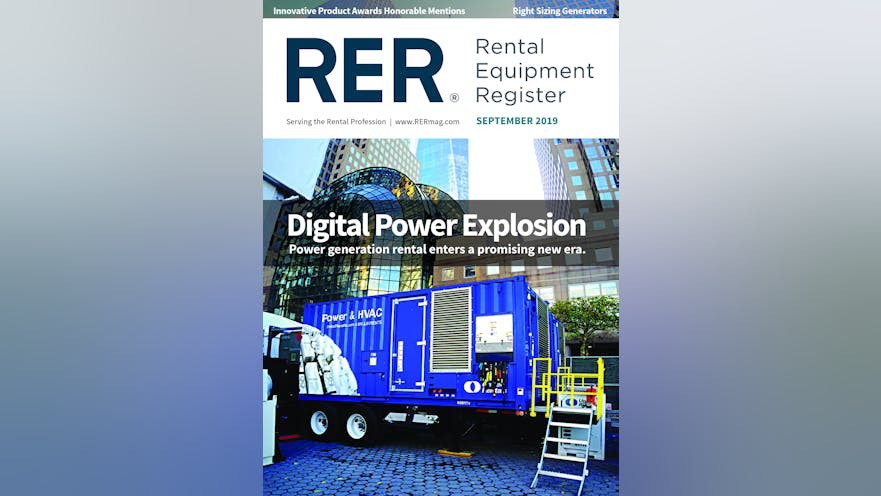Generators are among the most widely rented pieces of equipment in the rental industry. Most general rental companies have at least some in their fleet and are certainly capable of helping customers to rent basic small commercial generators required to take care of essential power needs when the lights go out or to power basic operations on a construction site.
But it’s a long way from knowing how to rent those basics to becoming a generator specialist or to powering major events or to being able to respond to complicated needs in the middle of a hurricane or in response to other natural disasters such as earthquakes, tornados, excessive heat waves, ice storms or floods.
And while the basic essentials of how to operate a generator and how to help a customer set up a generator probably haven’t changed too much over the years, many applications are becoming more challenging. A lot of technology is evolving, and this article will try to shine a light on some of the trends and changes in the power generation industry.
One of the biggest changes has been in the engines that power the generators. Not all manufacturers, nor all rental operators, agree that Tier 4 Final engines make generators more reliable or even more fuel efficient, although obviously the effect of reducing emissions is important in an environmentally conscious era. Some say the technology makes fuel efficiency better. Some aren’t so sure. But with the new technology, it has never more important to size the generator properly.
One of the main evolutions in the power generation rental industry in recent years has been in telematics systems – or telemetry as some prefer – becoming much more universal on the newer generators.
“One of the biggest advancements has been telematics becoming more user-friendly, and some manufacturers including them in packages straight from the factory,” says Tony Crandall, sales manager, power & construction equipment, Buckeye Power Sales, Canal Winchester, Ohio, a Kohler power distributor. “And if they’re not on the machine straight from the factory, there are lots of telematics products out there that are being brought forth helping us tremendously in safety, in knowing where our machines are, and being able to put stray fences around them. And they help the customers know more about what’s going on on their site, whether it’s the fuel level or the load or mechanical condition of the unit.”
“Telematics has been a huge part of our business,” says Todd Vallencour, power systems rental sales and operations manager for Carolina Cat’s power systems division. “It’s not just knowing where the equipment is or where it’s going from GPS technology, but understanding what kind of codes are being shown. We can also see what kind of loads are on the generator set so we can talk to our customers on the phone and say, ‘Mr. Customer, you’ve been running on 30 percent the entire time, that’s a pretty big generator, you can probably downsize the generator to a smaller size.’ We can use it a lot of different ways. Troubleshooting, right-sizing generators, understanding the location. At a lot of rental places, they have five or six things they can be looking at so they might be looking at a lot of screens, using a lot of software, but here you can see it all in one spot.”
“Caterpillar has its own internal telematics solution,” says Drew Wackerlin, southeast district rep for Cat Rental Power. “It goes by the name of CatRAM, it stands for Cat Remote Asset Monitoring, this can give you data in real time, everything from generator load to engine fault codes, to fuel levels to DEF levels on newer equipment. The trend I see is this is going to move from a reactionary phase notification system like ‘I now have a problem’ to more of a predictive ‘You’re going to have a problem soon.’ That’s how it’s going to be utilized in the future and we’re starting to see that now, especially on some of our experiences in the Third World on some of the large mining equipment, where uptime is so critical, we’re already using that as a predictive analysis to say ‘You’re going to need to schedule some maintenance on X,Y, or Z.’ ”
As Wackerlin points out, the growing sophistication of telematics systems allows rental companies as well as manufacturers to be able to analyze data that the telematics system is providing to be able to spot potential machine performance issues well before the problem causes a break down, thus preventing breakdowns before they happen.
“We feed the information into a centralized monitoring system where we have operators that monitor what we call CAN Bus and this is all the proprietary information that’s coming out of the engine,” says Steve Ferlita, power systems vice president, Ring Power Corp., St. Augustine, Fla. “It’s telling us voltage, amperage, fuel levels, battery voltage, so we look at that predictability model and we’re basically looking at high failure possibilities and predicting the failure before it occurs, keeping the total cost of ownership in check but keeping the reliability and dependability and productivity available for the generator customer. We’re looking at also the misuse of generators, that’s predictability. Service intervals play a big part of that, but the environment does as well. So it’s all about the analytical side of being connected fleet and trying to be predictive on what components on our engines might see some type of failure so that we can keep our customer informed that we need to come out to take the unit offline and make this repair to reduce any type of interruption in time or in standby applications.”
David Scott, senior vice president, specialty operations, United Rentals, refers to telematics systems as the “eyes and ears” of a rental company’s generator control system. “Both rental companies and customers monitor in real time generator performance, fuel levels, engine performance data and physical location while the generator is in use. In addition to monitoring, telematics also captures and communicates operating alarms, low fuel levels and unscheduled service disruptions. This information is essential for a technician when dispatched on a service call.”
”One of the bigger impacts that we’ve seen is in telemetry, monitoring remote and in some cases starting and stopping and the ability to sit in an office tower in Houston and to be able to monitor 200 or 300 oil sites in West Texas,” says Craig Wilkens, business development at Doosan Portable Power. “That has been amazing. I say that has been a tremendous jump forward and it has but I really think that’s where we’re going to see much more technology and applications in the future. I think we’re just scratching the surface there. If you can get some information remotely on your phone, and information is available today and most larger companies like United and others with larger fleets have that telemetry, you can narrow down as to whether or not it’s an electrical problem or a battery issue and that helps so much in terms of uptime.
“I think we’re going to see a digital expansion, I think we’re going to find a much better way for an alternator to work with a voltage regulator to work with a controller. I think the explosive growth will be in the controls and what we do with what we got.”
Parallel powering
Paralleling in electrical generator terms is the combination or synchronization of two electrical inputs by matching the output-voltage waveform of one electrical system with the voltage waveform of another system.
Paralleling is becoming more popular on jobsites, facilitating the distribution of power throughout the site and a smoother use of energy by synchronizing two electrical inputs by matching the output-voltage waveform of one electrical system with the voltage waveform of another system.
“One of the elements today is how much easier it is to parallel multiple machines together than it used to be five, 10, 15 or 20 years ago,” says Crandall. “It’s become much easier to accomplish, the controllers, the newer technology is playing nicely with one another so to speak. It’s just made that world so much better and easier to work with. Whenever we run into larger-scale projects, or projects where the load is changing constantly, sometimes it eventually will succeed the capabilities of one machine, so we’ll bring in a second one and we’ll parallel multiple machines together. “
“Paralleling has really helped out in the market,” says Wilkens. “It has forced everybody to learn about it, to know how to apply it and the paralleling control manufacturers have come along with include features that we never used to have like monitoring engine management schemes. One of the byproducts of Tier 4 by the way has been the fact that we are now paralleling some smaller generators.”
The growing use of paralleling has inclined some to use smaller units. “The big market now is for remanufactured units with four panels for paralleling technology, that’s where everything is going right now,” says Vallencour. “They can auto-synch and it makes things very seamless.”
“When we talk paralleling there are a lot of different applications,” says Ferlita. “Are we paralleling two generators together or are we paralleling the generators with utility and we must have utility-type protection to protect the generator from any back beating of utility? There are a lot of different paralleling applications, but we can go from the most simple -- of paralleling two generators to a common bus or common load -- to an extravagant and very tedious application where we take multiple large blocks of generators and parallel them to utility to subsidize the grid.”
More sophisticated controllers are becoming increasingly common. “We integrated Deep Sea controllers into our newest units, which allow for simpler troubleshooting methods and an easier-to-read screen to lessen interaction with the units,” says Brett Shive, senior field service technician, Allmand Bros. “Another significant enhancement from Allmand is the implementation of exhaust temperature management system to allow for auto-regeneration when a unit is not being run at a heavy-enough load. This eliminates wet-stacking issues on low loads, which are all too common with the new Tier 4 emissions standards.”
Shive says the integration of electronic fuel injection helps reduce fuel consumption. “Between improved diagnostic capabilities, automatic regeneration and EFI, operators are getting a lot more power and performance out of their generator units,” he notes.
Quiet power
Machines are much quieter than they used to be, most generators sold in the past five to 10 years are sound attenuated. “More and more regularly every customer is asking, ‘How quiet is this machine?’” says Buckeye’s Crandall. “There are certain government-type jobs where it has to be within a certain sound level or lower for you to even be able to bring it on to the site.”
Caterpillar has developed its XQ series, with the acronym standing for extra quiet. The machines are built with a weatherproof sheet metal enclosure.
The XQ units go well beyond the issue of noise. In addition to lower emissions levels, “they are much simpler to use, they’ve got intuitive digital controls,” adds Wackerlin. “Those controls allow remote monitoring, they are more fuel efficient, they have a high-pressure fuel system with electronic controls and they are more compact, meaning there is better power density for the size of the unit, so they are easier to transport as well.”
Ferlita says the Caterpillar XQ product has a lot of safety built in to the standard XQ package. “One of the things we have is you can’t open a bus bar area without the generator recognizing that the operator went in there and was exposed to a live bus bar,” he says. “The way Caterpillar designed it is when you open that area of live voltage, the generator recognizes that by a pressure switch that tells the breaker to shock it open and it opens the breaker to where if you were to accidentally come in contact with the breakers or the bus bars you wouldn’t get electrically shocked or killed. Also, there are many safety protocols, such as a three-point hand touch lift when you’re stepping on the units, and the safety shut trip features that are built into the system.”
Rightsizing generators
With the growth in the usage of Tier 4 engines, there is a greater need for focusing on load profiling.
“What has really changed is how you manage those engines,” says Kevin Day, executive vice president of Alliance North America or ANA Corp. “The digital controllers now interface with the operator allowing them to monitor and manage those load profiles. That’s one of the biggest changes that has happened. Then you get into the technology of dynamic heat generators, or heaters that you use to help try to control the light loading of the units and avoid wet stacking of the engines.”
As Day explains, a common practice for rental companies in the past was if a customer came to a rental center to rent a generator and the company didn’t have the right size for the required application, they might rent him one three or four times larger for the same rate. That way the rental center got its utilization, took care of the customer and didn’t have to worry about him going to a competitor.
“But today it’s really challenging for that rental operator because if he does that, if the customer isn’t using the generator that’s sized or profiled for his application, now you have this light loading, this wet stacking, you have all this carbon buildup, and you get all kinds of issues that can happen with the generator.”
Energy Storage
Perhaps the most significant new technological development in power generation is energy storage or power storage. While it’s not entirely new, it is growing in popularity in power generation rental. Energy storage is, essentially, the capture of energy produced at one time for use at a later time.
ANA Corp. is distributing a split phase hybrid power unit called Grid to Go, which provides on-demand power, either independently or in conjunction with a diesel generator. When working with a diesel generator, it allows the generator to work as efficiently as possible with spare energy being stored into the unit’s high-power battery pack. The Grid to Go is powered by a series of lithium ion batteries, distributing power through an inverter system. When working as a hybrid system with a diesel generator, it reduces maintenance costs and fuel usage.
Day explains how power storage works in theory.
“A perfect example would be if you think about a submersible water pump,” he says. “A submersible water pump typically has three to five times the motor starting need versus the actual running. So, for that submersible water pump to really get started it has all kinds of cranking need. But once it starts to spin, it drops off dramatically. That’s where combining power storage and a diesel generator together allows you to right-size the generator to meet the need of the pump without having to have a larger size just because you’re going to have that start-up demand.
“You have to try to reduce fuel usage, and you have all the issues that the engines deal with when you put too large of a generator into an application that needs something much smaller. A rental operator might have to have a bigger fleet today than ever because he can’t take one of his larger generators and rent it for a smaller application. It used to be you had a couple of 25s, you had some 45s, you had some 65s, and if you were out of 25s and all you had left were 65s and [a customer] needed a generator for a smaller application, you’d say, ‘No problem, I’ll just give you the 65.’
“Today if you had a 25 and you had a storage unit that was sized, you could essentially say yeah that will handle your need for a larger application, I’m giving you essentially a hybrid system.”
Doosan’s Wilkens and others contacted for this article agree that energy storage will grow in popularity in the future.
Aggreko, the world’s leading provider of temporary power, temperature control and energy services, recently added mobile and modular energy storage to its 10-gigawatt fleet with the launch of the Y.Cube, a 1-megawatt standard unit housed in 20-foot containers. The system can cover a variety of applications from 1 MW up to multi-MW power output and is available in two versions: a 30-minute “power” unit and a 60-minute “energy” unit. The 20-foot container houses batteries, inverters, heating ventilation and air conditioning (HVAC), fire protection and auxiliary components. These are tested and pre-assembled by Aggreko experts and controlled by intelligent software. It is designed for a wide ambient temperature range from -20°C to +50°C to match the often-challenging requirements of remote customer sites.
An Aggreko spokesman says battery storage systems offer the flexibility required for safe and stable use of wind and solar power and increase the efficiency of thermal units.
Another important development has been the growth in the usage of biofuels. As the Warren Cat website explains: “Biofuels are an excellent example of new technology being put to use in generators. Biodiesel is a blend of conventional diesel fuel and other combustible organic products such as vegetable matter. Biofuel is another hybrid energy provider that works with diesel having natural gas injected into the air intake system for added economy.”
To sum it up, the power generation rental industry is a dynamic one, with new technologies being introduced to the market on a regular basis. With growth in a variety of more environmentally friendly fuels, in the advancement of telematics, digital controllers, power storage and more, there is a digital power explosion that is just beginning a process of transforming the way energy is produced and brought to market.
